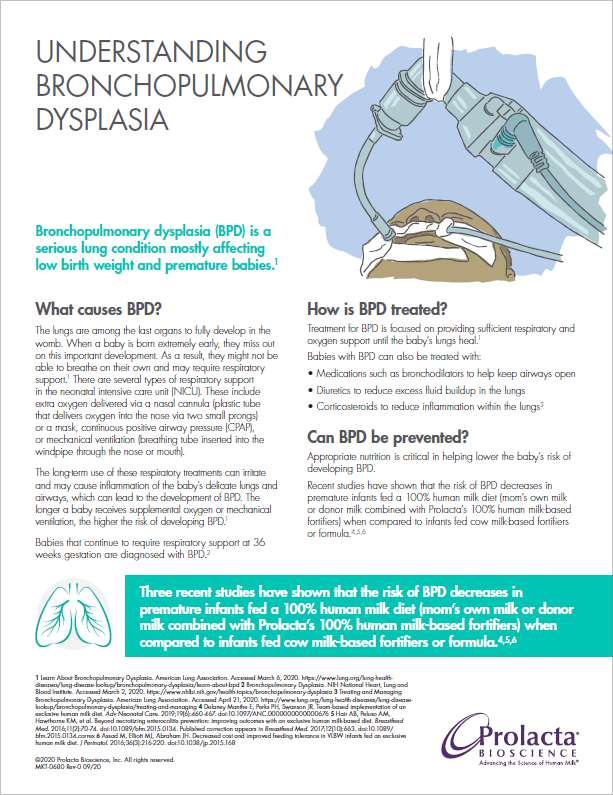Fact Sheet
Parent bronchopulmonary dysplasia fact sheet

Understanding Bronchopulmonary Dysplasia
Bronchopulmonary dysplasia (BPD) is a serious lung condition mostly affecting low birth weight and premature babies.1
What causes BPD?
The lungs are among the last organs to fully develop in the womb. When a baby is born extremely early, they miss out on this important development. As a result, they might not be able to breathe on their own and may require respiratory support.1 There are several types of respiratory support in the neonatal intensive care unit (NICU). These include extra oxygen delivered via a nasal cannula (plastic tube that delivers oxygen into the nose via two small prongs) or a mask, continuous positive airway pressure (CPAP), or mechanical ventilation (breathing tube inserted into the windpipe through the nose or mouth).
The long-term use of these respiratory treatments can irritate and may cause inflammation of the baby’s delicate lungs and airways, which can lead to the development of BPD. The longer a baby receives supplemental oxygen or mechanical ventilation, the higher the risk of developing BPD.1
Babies that continue to require respiratory support at 36 weeks gestation are diagnosed with BPD.2
How is BPD treated?
Treatment for BPD is focused on providing sufficient respiratory and oxygen support until the baby’s lungs heal.1
Babies with BPD can also be treated with:
- Medications such as bronchodilators to help keep airways open
- Diuretics to reduce excess fluid buildup in the lungs
- Corticosteroids to reduce inflammation within the lungs3
Can BPD be prevented?
Appropriate nutrition is critical in helping lower the baby’s risk of developing BPD.
Recent studies have shown that the risk of BPD decreases in premature infants fed a 100% human milk diet (mom’s own milk or donor milk combined with Prolacta’s 100% human milk-based fortifiers) when compared to infants fed cow milk-based fortifiers or formula.4,5,6
Three recent studies have shown that the risk of BPD decreases in premature infants fed a 100% human milk diet (mom’s own milk or donor milk combined with Prolacta’s 100% human milk-based fortifiers) when compared to infants fed cow milk-based fortifiers or formula.4,5,6
References:
1 Learn About Bronchopulmonary Dysplasia. American Lung Association. Accessed March 6, 2020. https://www.lung.org/lung-health-diseases/lung-disease-lookup/bronchopulmonary-dysplasia/learn-about-bpd
2 Bronchopulmonary Dysplasia. NIH National Heart, Lung and Blood Institute. Accessed March 2, 2020. https://www.nhlbi.nih.gov/health-topics/bronchopulmonary-dysplasia
3 Treating and Managing Bronchopulmonary Dysplasia. American Lung Association. Accessed April 21, 2020. https://www.lung.org/lung-health-diseases/lung-disease-lookup/bronchopulmonary-dysplasia/treating-and-managing
4 Delaney Manthe E, Perks PH, Swanson JR. Team-based implementation of an exclusive human milk diet. Adv Neonatal Care. 2019;19(6):460-467. doi:10.1097/ANC.0000000000000676
5 Hair AB, Peluso AM, Hawthorne KM, et al. Beyond necrotizing enterocolitis prevention: improving outcomes with an exclusive human milk-based diet. Breastfeed Med. 2016;11(2):70-74. doi:10.1089/bfm.2015.0134. Published correction appears in Breastfeed Med. 2017;12(10):663. doi:10.1089/bfm.2015.0134.correx
6 Assad M, Elliott MJ, Abraham JH. Decreased cost and improved feeding tolerance in VLBW infants fed an exclusive human milk diet. J Perinatol. 2016;36(3):216-220. doi:10.1038/jp.2015.168
